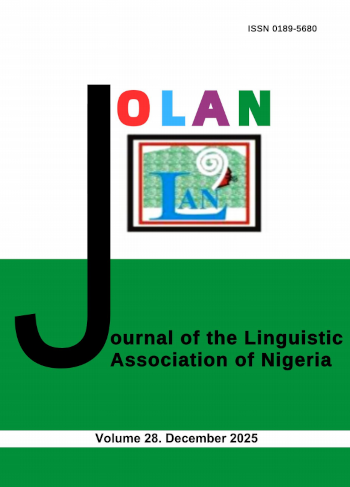Pronouns and the Activation of Focus in Aíká: A Minimalist Description
Keywords:
focusing, derivation, Aika pronouns, new and given information, AíkáAbstract
Focusing is the previously unshared/unfamiliar (i.e. new) information. It is observed that not all pronoun types can activate focusing in Aíká. However, little has been said on how pronoun can be focused in Aíká. Therefore, this paper adopts the Copy Theory of movement in Minimalist Program as its theoretical framework and investigated Aíká pronouns in focus constructions with regards to identifying focusable vs unfocusable pronouns and derivation of pronoun focusing. The paper identifies two types of personal pronouns- emphatic [+emphasis] and unemphatic [-emphasis] pronouns. Emphatic pronoun is preposeable just like other DPs. Hence, it is movement licensing, activating focus without inducing pronoun substitution in the clause. It occupies spec-Focus Phrases as new information. Unemphatic pronoun is inert to movement. It does not move to specFocP/Emphatic Phrase (EmpP). It specifies [-emphasis; -focus] as given information. In derivation of pronoun focusing, the paper concludes that the computation selects emphatic pronoun for focus while unemphatic pronoun is selected for given information without substituting one pronoun for the other. The target derivation is determined by what the expected output is because that language speakers’ use pronouns referentially for discourse purposes as new/focus on the one hand and given/topic information on the other hand.
References
Abimbola, O. 2008. Aspects of syntax of Ayánrán. Long Essay. Department of Linguistics and Nigerian Languages, Adekunle Ajasin University, Akungba-Akoko.
_________. 2014. The Ìỵ́ ínṇ́ ọ clause structure. Masters’ Project. Department of Linguistics and African Languages, Arts, University of Ibadan, Ibadan.
_________. & Adekunle, C. 2014. An Appraisal of the Sociolinguistics Situation and in the Ayánrán community. Eds. O. Taiwo and A, Olayiwola, Globalizing the Local: African Languages and Cultures at the Border of Technology: A festschrift in honour of Diipo Gbenro, Ṣayọ Oyerinde, Akin Adetunji, Oyekola Ọmọtoye, Bayọ Akinpẹlu, Ayinla Popoọla and Oye Oyewole. Crown Goldmine Communications Ltd. Ibadan. Pp.179-189.
_________. & Olaogun, S. 2016. Interrogatives in Ìỵ́ i ̣́ nno ̣́: A Unified Analysis. New findings in West African languages and literature: in commemoration of the 5oth anniversary of the West African Linguistic Society (WALS). Eds. O. Taiwo, and L. Yuka, Ibadan: The West
African linguistic society (WALS)/La Société de Linguistique de L’afique de Lóuest (SLAO). Pp. 47- 58.
_________. & Taiwo, O. 2017. A Minimalist Description of Aika Pronouns. JOLAN: Journal of the Linguistics Association of Nigeria. Vol.20.No.1 Pp.28-39.
Abney, S. 1987. The English Noun Phrase in its Sentential Aspect. Thesis submitted to the Department of Linguistics and Philosophy, Massachusetts Institute of Technology: MIT.
Aboh, E. Hartman, K. and Zimmerman, M. 2007. Focus and Grammar: The Contribution of African Languages. Trends in linguistics: Focus Strategies in African Languages, the interaction of focus and grammar in Niger-Congo and Afro-Asiatic. Eds. Aboh E. O., Hartman, K. and
Zimmerman, M. Berlin: Mouton de Gruyter. 1-12.
Arohunmolase, O. et al. 2006a. A Brief Linguistic Description of Iigau & Iyinno. And the Outlines of Social and Historical Situation of the Language and their Communities. UNESCO. Ondo: Lekoba Publishers.
___________. 2006b. Iyinno I Be Winnigin (1). UNESCO. Ondo. Lekba Publishers.
___________. 2006c. Iyinno Alphabetical Word Lists and Vocabulary Items. UNESCO. Ondo: Lekoba Publishers.
Arokoyo, B. E. 2013. Unlocking Focus Constructions. Ilorin: Chridamel Publishing House.
Awobuluyi, O. 1978a. Essentials of Yoruba Grammar. Ibadan: Oxford University Press.
___________. 1978b. Focus constructions as noun phrases. Linguistic Analysis 4: 93-114.
__________. 1987. Focus constructions as noun phrases: a reply. Yorùbá: a journal of the Yoruba studies association of Nigeria. New series No. 1.
__________. 1992. Aspects of Contemporary Standard Yoruba in Dialectological Perspective. Iṣọla, A. (ed.) New Findings in Yoruba Studies. (J. F. Ọdunjọ Memorial Lectures Series No.3) Ibadan/Lagos: J. F. Ọdunjọ Memorial Lectures Organizing Committee, pp. 1 – 79.
__________. 2008. Ẹ̀kọ́ Ìṣẹ̀dá-Ọ̀rọ̀ Yorùbá. Montem Paperbacks. Akure.
__________. 2013. Ẹ̀kọ́ Gírámà Ẹ̀dè Yorùbá. Atman Limited. Oṣogbo.
Awoyale, Y.1995. “The Role of Functional Categories Syntax: The Yoruba Case”. In Owolabi, K. (ed). Languages in Nigeria: Essays in Honour of Ayo Bamgbose. Ibadan: Group Publishers.
Bamgbose, O. 1990. Fonọ́lọ́jì àti Gírámà Yorùbá. Ibadan: University Press PLC.
Chomsky, N. 1995. The Minimalist Program. Cambridge, MA: MIT Press.
________. 2007. Approaching UG from below. MIT. Accessed on 30/12/2017. Hornstein N. Nunes, J. and Grohmann, K. 2005. Understanding Minimalism, Cambridge: Cambridge University Press.
Ibikunle, A. S. 2008. Aspects of the Phonology of Ayanran. Long Essay. Linguistic and Nigerian Languages, Adekunle Ajasin Univesersity, Akungba-Akoko.
Ilori, J. F. 2010. Nominal Constructions in Igálà and Yorùbá. Thesis. Linguistics and Nigerian Language, Adekunle Ajasin Univesersity, Akungba-Akoko.
Olanipekun, T. 2008. The Ìỵ́ínṇ́ ọ verb phrase. Long Essay. Department of Linguistics and Nigerian Languages, Adekunle Ajasin University, Akungba-Akoko.
Owolabi, D.K.O. 1987. Focus construction as noun phrases: a critique. Yorùbá, New Series, No.1, 45-62.
Radford, A. 2009. An Introduction to English Sentence Structure. New York: CUP
Rizzi, L. 1997. The fine structure of the left periphery. Elements of Grammar. Ed. L. Haegeman, Doerdrecht: Kluwer academic publishers. 281-337.
Szabolcsi, A. 1983. The possessor that ran away from home. The Linguistic Review. Vol.3, pp. 89 – 102.














